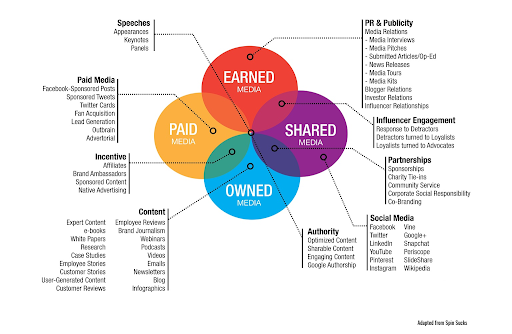If you spend a lot of time and effort developing marketing strategies and social media strategies, you might think you don’t need a public relations plan. But that couldn’t be further from the truth. While your marketing action plan and your PR strategy should complement each other, they are two different things.
If you’re new to the PR game, we will give you a crash course on creating a strong PR strategy so you can begin formulating your plan immediately.
What Does PR Mean?
PR means cultivating and maintaining a favorable public image for a company or brand in the marketing sphere. If you’re unfamiliar with PR, you might wonder how that differs from marketing.
Marketing’s job is to promote a specific product or service and includes market research and advertising. The end goal of a successful marketing campaign is sales while a PR strategy can have many goals, including reaching a target audience, building positive relationships with influencers, including journalists in your sphere, building customer loyalty, and more.
What is a PR Strategy?
A PR strategy is created to improve your brand in some way. PR can help get the word out to potential customers if your brand is new. PR can help increase your brand’s authority. If your brand has suffered a scandal, crisis management PR can help improve your public perception.

Why Having A PR Strategy is Important?
PR plays a big part in paving the way for all successful marketing campaigns in your future. Think about it; if a tree falls in the woods and no one is there to hear it, did it make a sound? Not in the world of marketing, it didn’t!
PR can send traffic to your website, get you onto the social media posts and blogs of influencers whose audience you want to be in front of, and book you as a guest on podcasts whose audiences are in your target market. Tip – If your brand is an ecommerce business, you can also leverage some e-commerce automation tools to help promote your brand on social media.
Podcast appearances can be especially beneficial. What does a good podcast do? It tells a story which is the same thing a good PR strategy does. Two-thirds of modern consumers prefer podcasts to television. And podcast audiences are loyal, affluent, and educated, precisely the kind of customers any brand wants. If you want to get in front of that kind of audience, Postaga can help.
Owned Media Vs. Paid Media Vs. Earned Media
So what are the types of media? You didn’t know there were different types? That’s okay; we’ll explain them and how they relate to your PR and overall business strategy.

Owned Media
Owned media is the content your company controls, including:
- Social media pages
- Blog posts
- Website
- Email newsletters
- News releases
Paid Media
Paid media is media you’ve paid for as part of your strategic PR plan, including:
- Paid ads
- Paid guest posts
- Social media ads
- Sponsored events
Earned Media
Earned media is organic mentions, word of mouth, and social proof, all very desirable things that can help you reach a broader audience. It’s not easy to get, but the best kind of media. Earned media includes:
- Shares
- Likes
- Mentions
- Reposts
How a PR Strategy Helps Your Brand
A solid PR strategy has a lot of benefits and advantages for your business.
#1 Improves Brand Awareness
Brand awareness means making potential customers aware of your company’s existence and ensuring that they remember it, including things like your logo, slogans, products, and messaging. There is something called “The Marketing Rule of 7.”
The Rule states that a potential customer needs to “hear” your message at least 7 times before they make purchasing decisions. Luckily, in this our digital age, you have many more than 7 outlets through which you can connect with what you hope will become your customer base.
#2 PR Can Build Trust & Credibility
I’ll go back to our podcast points from above. People don’t want to spend their hard-earned money on sub-par products or services. That’s why authority websites like Consumer Reports and Reditt’s Buy It For Life are popular.
Podcast hosts have a very intimate relationship with their audience. Think about how many of us fall asleep at night listening to our favorite show. We don’t let just anyone whisper bedtime stories to us! Listeners trust podcast hosts; they trust the guests they interview and the things they recommend or advertise. Podcasters know that breaking that trust hurts their bottom line, so they don’t.
When you get in front of a host’s podcast audience, some of the trust and credibility the host has with the audience is transferred to you.
#3 PR Utilizes Greater Reach
Essentially, PR is a megaphone. Far more people can hear your message when it’s spoken through a megaphone.
#4 Reputation Management Through PR
Ideally, you can spend your PR planning (and budget) polishing your company’s halo, highlighting the good things about it and the good things it does. But sometimes, something happens that gives your company a black eye in the public’s minds. In these cases, your public relations campaign has to switch to crisis management mode.
A crisis communication plan can be as relatively minor as working to drown out negative reviews, or it can mean coming clean, being transparent, and addressing how a major faux pas, a customer data breach, for example, will be addressed and what steps will be taken to repair the damage and make sure it never happens again. You never want to need it, but if you do, you’ll be glad you have it, a bit like a plunger!
How to Create a PR Strategy
Ready to get it done? Great, here we go in 8 simple steps!
1. Create Goals For Your PR Strategy
A wish without a plan is… something, something you saw on Tumbler written in Comic Sans font in 8th grade! But the point remains that you need to have clear goals before creating a successful strategy.
What is the result you want to attract new customers, improve community relations, connect with relevant media contacts? That is your starting point for creating your PR strategy.
2. Set Your PR Project Timeline
Any goal should have a plan timeline. I want to lose X pounds in X months. I want to have a networth of X by age X. It’s not just the goal that’s important; it’s the deadline for the goal. Creating a timeline helps you measure the ultimate success of your PR campaign plans.
It might be something like, Increase organic social media mentions by X% in six months’ time.
This might entail multiple campaigns to reach an ultimate goal. In that case, having a timeline is even more critical since one campaign builds on the former.
3. Identify Your Target Audience
Who you’re talking to not only decides what you say but where you say it (or who is saying it for you). Who is your target audience, what social media channels do they congregate in, and who do they trust and listen to?
You have to speak their language and from a place where they’ll see it. This isn’t just for a PR campaign. Knowing your key audience is basically Step #2 in your business plan after deciding what your product or service will be!
4. Set Up the Right PR Campaigns
Once you’ve accomplished Step #3, you can decide which of the following kinds of campaigns are best. Each type of campaign promotes your business with journalists, influencers, and prominent bloggers, but you don’t want to spread your efforts too thin, so make strategic decisions when choosing your campaign type.
Guest Posting Campaigns: A guest post campaign can find websites where you can submit content to a broader audience. It’s a popular link-building strategy that can help you earn backlinks from sites with domain authority. In Postaga, you can search blog post topics relevant to your area of expertise.
Podcast Campaigns: We’ve discussed how powerful podcasts are for a business owner. I was a booker for a podcast in my past life, and I can tell you it’s not easy to score an interview. Postaga’s Podcast Outreach can help. The tool finds podcasts in your subject area, gets their contact details, and sends them personalized email outreach sequences pitching you as a guest to a potentially massive audience.
Reviews Outreach Campaign: A good review can go a long way in increasing sales. How far? A study by Northwestern University shows that having at least five quality product reviews can increase the likelihood of purchase by 270%! Postaga can help you find sites that have reviewed your competitor’s products and reach out to them for a similar review.
Product Promotion Campaigns: When you’re doing a product release, your marketing and PR campaigns need to work in concert. Remember at the start of the article when we discussed the difference between marketing and PR.
Marketing promotes a specific product or service. PR’s job is to amplify your marketing campaign.
Offer Expertise Campaign: You can’t fake it until you make it when you’re putting yourself out there to write a guest post or to be interviewed by a podcast or traditional media outlet as an expert on something. If part of your PR strategy is offering yourself up as an expert, you better be one!
5. Write a Compelling Pitch
“Words are, of course, the most powerful drug used by mankind.” – Rudyard Kipling
“If you don’t tell your story, someone else will.” – Unknown
Writing is part of what I do for a living. Not everyone is a great writer. And you don’t have to be to write a compelling PR pitch. But no one knows the story you want to tell as well as you do. Long story short, craft the email copy you’ll be sending out.
We have templates that can make it easier if you’re no Hemingway, but your voice should definitely be in your email pitches.
6. Personalize Your Message
No matter the ultimate goal of your PR campaign, you’re at some point at least going to be asking someone, likely a total stranger, to do you a favor; interview you, talk about you, review your product, share their audience.
There is nothing wrong with using templates, but you have to add some personalization to it. People react poorly to what are clearly clinical “form letters” that have been sent out to who knows how many other people. Did you ever get a message on a dating app that the person had obviously just copied and pasted to as many people as possible, hoping to win a numbers game? Did you respond? This is like that!
Frankly, personalization just won’t cut it these days; if you want positive responses, hyper-personalize your messages.

7. Find Relevant Contacts
The greatest, most hyper-personalized messages won’t help your campaign if the person they’re sent to isn’t in a position to give you an answer or the contact list you have is out of date. Sussing out that information can be time-consuming when you’re pitching to dozens of people (or more).
Fun fact! Postaga not only collects the email addresses but also provides you with verified contacts. Postaga always finds the person in charge of your needs. You don’t want to talk content strategy with the Lead Programmer! Postaga finds the contact details for the content editor/content marketing manager, the decision-maker.

8. Measure the Results
What gets measured gets managed. And improved. That goes for your PR plan, marketing plan, cold email outreach campaign, anything that impacts your business. Use your analytics tools to keep an eye on:
- Delivery rate
- Open rate
- Reply rate
Compile all of the data into a final report; what worked and what didn’t? This is beneficial information because it can be used to fine-tune your future PR efforts.
To Wrap It All Up
Marketing and advertising get a lot more attention than PR. Perhaps because when people hear the term, they think PR is something only celebrities have. Not true! Public relations are for businesses too, big and small.
If you’re a small business, you might think you can’t afford PR. You may not be able to hire an outside PR company or bring a Director of Public Relations on staff, but you don’t have to. Postaga has many tools that will help you create and implement a public relations strategy for your business, no matter the size. Together, we can get the word out!
Free 14-Day Trial
Start building relationships now with your fully-featured 14-day trial!
How We Compare
Terms | Done-For-You Terms | Privacy | Write For Us | Press
© 2025 Postaga. All Rights Reserved. Made with 
